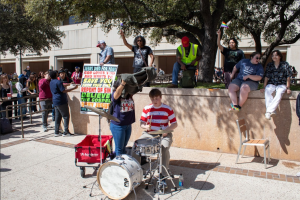Review: Seeking solace in ‘El Norte’
Enrique and Rosa’s journey to the U.S.
September 28, 2021
In a film that balances poignancy with distress, myth with assurance and heroics with tragedy, there is a chord that is struck in tender moments and hopeful wishes. Whether those be glimpses of America through tattered home magazine pages or odes to gods of ancient origin, “El Norte” sits as a cinematic journey of faith and estrangement.
“El Norte,” director Gregory Nava’s epic, follows siblings Enrique and Rosa on their journey toward the United States. As part of an indigenous Mayan community living in the mountains of Guatemala, they are stuck with irrevocable destruction; violence occupies their young world. A massacre upon their rather harmless community serves as the catalyst to their escape.
The structure of “El Norte” is quite impressive. Image and sound accompany the viewer uniquely throughout the film. The sound design often utilizes native flutes, wildlife and voice to immerse us into its world. The film’s soundtrack — often dark, often comedic — guides us with Enrique and Rosa. The film’s balance between comedy and critical fluctuates several times. The film’s second act begins to lighten the mood, so to speak, as Enrique and Rosa arrive in Mexico. The editing hyper-focuses on everyday objects, that when approached with the lens of their Mayan culture, carries great power as the film concludes.
Another stylistic choice is the film’s noticeable three-act structure. This idea is not something foreign to filmmaking, though El Norte’s intermission-like setups give the viewer the notion that each of these brief interludes allows for rest or recuperation. Each of their titles alludes to a significant moment depicted in the film: moments that inevitably affect Enrique and Rosa.
Magical realism and fantasy imbue much of El Norte’s three acts. Very early in the film the siblings’ father, Arturo, notes that the peasants are merely “arms to do their [wealthy people] work.” This is a quote that defines and sets up El Norte’s view of the immigrant’s body. There is the analysis around human limbs, discomfort and disembodiment in the film. The film utilizes several keen uses of imagery. The film’s repeated use of circles is apparent in its cutaways to the moon, heads and in the literal journey depicted in the film: the initiation of the siblings, due in part to the grandeur of the North.
The film’s third act culminates in a heavy, gut-wrenching blow to the siblings’ journey. Rosa laments to Enrique on their loss of home. The north provided no such comfort or peace, acceptance wasn’t found. In the film’s poignant final moments, its full-circle story, Enrique is chosen for his “strong arms,” his own lament that he has become what his father warned him about.
“El Norte” does not mince on the hardships an immigrant faces. The constant fear and dissociation. And though the film is nearly 40 years old, its lens into the hardships of the migrant is felt even now.
In continued observance of Hispanic Heritage Month, we want to highlight important films from Hispanic artists.“El Norte” can be found on Amazon Prime Video and is available for rent on YouTube.








